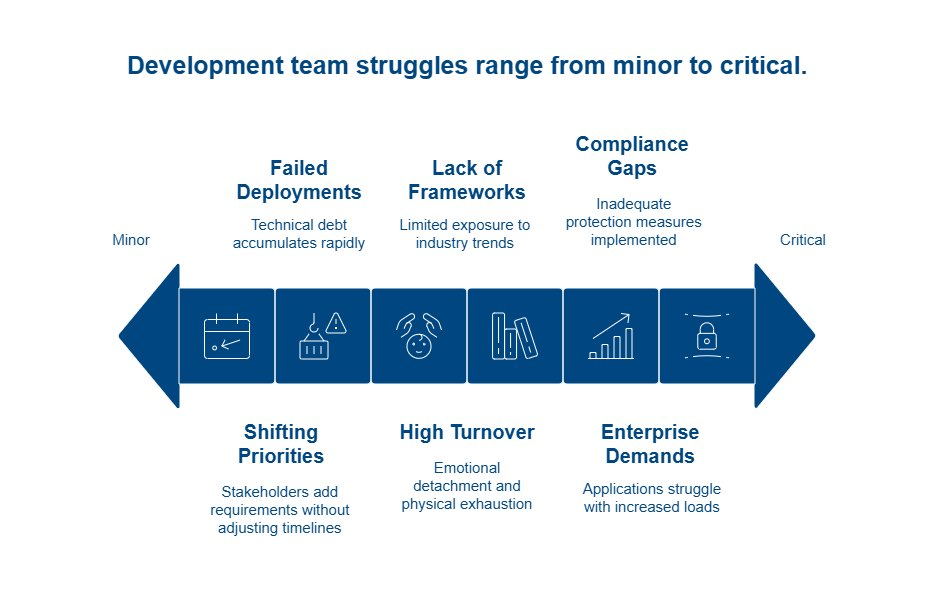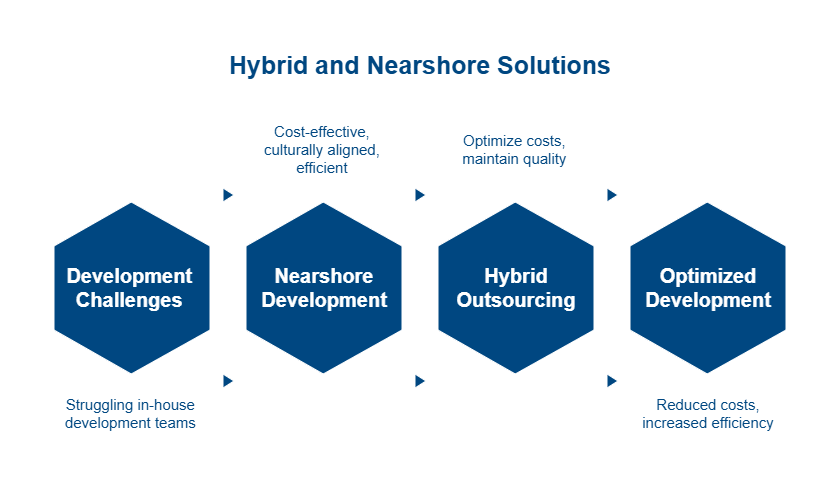In-House Software Development: Warning Signs Your Team Needs Help

In-house software development projects fail more often than most leaders care to admit. A staggering 68% of these initiatives exceed their budgets, while poor software quality costs U.S. companies $2.42 trillion every year. As someone who’s guided numerous organizations through development challenges, I’ve witnessed firsthand how quickly promising projects can spiral into costly disasters.
Unfortunately, the problems don’t end with budget overruns. Software development challenges often compound when technical debt accumulates, with 72% of development teams reporting its presence in their projects. Furthermore, fixing defects after deployment can be up to 100x more expensive than addressing them early in development. When you consider that 96% of all web applications contain at least one serious vulnerability, the risks of continuing with a struggling in-house team becomes painfully clear.
In this article, I’ll walk you through the critical warning signs that your in-house software development team needs help. We’ll explore the early indicators of trouble, what happens when internal capabilities hit their limits, and the substantial business risks of ignoring these problems. Most importantly, we’ll discuss how hybrid and nearshore solutions can provide access to specialized talent while maintaining legal protections and reducing costs – before your project becomes another cautionary statistic.
Key Takeaways
Recognizing early warning signs can prevent costly development disasters that plague 68% of in-house software projects.
- Watch for scope creep, failed deployments, and team burnout—these signal your development team needs immediate support
- Security gaps and outdated expertise create $4.88 million average breach costs and compliance violations
- Client churn accelerates when 90% of users abandon poorly performing applications after just one bad experience
- Nearshore partnerships offer a 40% cost reduction while maintaining U.S. legal protections and cultural alignment
- Hybrid outsourcing models provide 24/7 development cycles and scalable expertise without premium in-house costs
Ignoring these warning signs transforms manageable technical challenges into business-threatening crises. Smart companies proactively seek specialized partnerships before problems compound, maintaining strategic control while accessing world-class talent at sustainable costs.
Early Warning Signs Your Team Is Struggling
Recognizing the warning signs of a struggling development team can save your business from costly project failures. Throughout my career advising software companies, I’ve identified three critical indicators that consistently precede major development crises.

Repeated scope creep and shifting priorities
The constant reshuffling of project priorities is often the first sign your team is heading for trouble. In today’s competitive landscape, a staggering 52% of software projects experience scope creep, with 43% suffering serious consequences including missed deadlines, blown budgets, and compromised quality.
I frequently observe this pattern: stakeholders add requirements without adjusting timelines or resources. This happens because companies naturally evaluate market conditions and adjust priorities to remain competitive. However, without a formal change control process, your development team drowns in conflicting requests, especially with multiple stakeholders involved. Consequently, developers focus on short-term solutions rather than creating a solid, maintainable foundation.
Inconsistent code quality and failed deployments
Poor code quality isn’t just a technical concern—it’s a business liability. Research shows developers spend approximately 50% of their time debugging, time that could otherwise be dedicated to innovation or feature development.
Failed deployments represent another critical warning sign. These aren’t merely technical hiccups but symptoms of deeper issues. When deployments consistently fail, technical debt accumulates rapidly, especially in projects with aggressive timelines. This debt compounds as more “quick fixes” are implemented, eventually creating a labyrinth of patches that becomes impossible to maintain or extend.
Burnout and high turnover among engineers
Perhaps the most alarming signal is burnout among your development team. The tech industry faces a troubling 13.2% turnover rate—the highest across all sectors. Additionally, up to 80% of programmers experience burnout, leading to decreased productivity, increased sick time, and ultimately, resignation.
Burnout manifests as emotional detachment, decreased professional efficacy, and physical exhaustion. This isn’t merely a personnel issue—Stanford researchers estimate burnout leads to nearly $190 billion in healthcare costs annually. For your development team specifically, burnout results in slower delivery speed, lower quality code, poorer project outcomes, and ultimately higher turnover.
When Internal Capabilities Hit a Wall
Even the most capable in-house development teams eventually encounter technical limitations that hinder progress. Over my years advising software companies, I’ve observed that these barriers typically emerge as organizations grow beyond their initial capabilities.
Lack of expertise in modern frameworks
Many in-house teams struggle with limited exposure to industry trends compared to specialized firms. This often leads to outdated methodologies and compromised software quality. As technologies evolve at breakneck speeds, internal teams frequently develop knowledge silos around legacy systems that become difficult to scale or transfer.
This skills gap creates a dangerous scenario—60% of companies that attempted in-house software development without sufficient expertise faced critical security and operational issues. Moreover, when key developers leave, organizations must deal with lost institutional knowledge, disrupted workflows, and extended onboarding times for replacements.
Inability to meet enterprise-level demands
In-house applications frequently fail to address future scalability needs. As your business grows, these applications struggle with increased loads, leading to downtime and inefficiencies. According to McKinsey, only 30% of in-house software projects successfully meet deadlines, stay within budget, and achieve desired functionality.
The complexity increases when specialized roles like DevOps engineers and architects become necessary. Many companies either don’t recognize their importance or cannot justify dedicated positions, creating a painful dilemma: overspend on underutilized experts or risk project failures due to skill gaps.
Security and compliance gaps
Perhaps most alarming is that 96% of web applications contain at least one serious security vulnerability. Without experienced security professionals, in-house teams often implement inadequate protection measures. EY’s Global Information Security Survey reveals that 59% of organizations believe their in-house applications aren’t adequately protected against cyber threats.
Simultaneously, the regulatory landscape continually evolves, with requirements frequently changing and becoming geography-specific. The average global data breach now costs an astounding $4.88 million, making security failures catastrophically expensive.
The Business Risks of Ignoring the Problem
The financial consequences of ignoring development team struggles can be devastating for your business. Throughout my career, I’ve witnessed companies suffer major setbacks by dismissing early warning signs until it was too late.
Client churn and reputational damage
When software quality deteriorates, customer loyalty evaporates rapidly. Studies show that 60% of customers stop doing business with a company after just one poor experience. Even more concerning, 90% of app users reported abandoning applications due to performance issues.
Indeed, poor software quality cost U.S. businesses a staggering $607 billion in 2022 alone. This figure encompasses not just direct expenses but also lost opportunities and damage to your market position. For mid-sized enterprises, these failures translate to downtime costs exceeding $300,000 per hour.
Delayed product launches and lost revenue
Every postponed release drains your bottom line. In competitive markets, delays directly shrink your revenue window as competitors capture market share. In the electronics industry, product launches delayed by 9-12 months can cost 50% of anticipated revenues.
Furthermore, research from McKinsey indicates that companies using predictive analytics reduce customer churn by up to 15%. Without these capabilities, you’re essentially flying blind while competitors gain decisive advantages.
Legal and IP risks in poorly managed projects
Intellectual property complications represent another serious threat. Unless you’ve established clear IP terms in writing, developers might legally own code even if you paid for it. Subsequently, during funding rounds or acquisitions, this oversight can delay or devalue your entire business.
Amid rushed agile workflows, legal reviews often get sidelined. In addition, inadequate software security exposes you to compliance violations and data breaches. Organizations failing to address these issues face multimillion-dollar fines, operational restrictions, and permanent reputation damage.
A Smarter Path: Hybrid and Nearshore Solutions
When facing the development challenges we’ve discussed, forward-thinking companies are increasingly turning to hybrid and nearshore solutions as strategic alternatives to struggling in-house teams.

Benefits of nearshore software development solutions
Nearshore software development offers a powerful balance of cost-effectiveness, cultural alignment, and operational efficiency. This approach involves partnering with teams in neighboring countries, particularly Latin America for U.S. companies. The IT outsourcing sector is projected to generate USD 541.10 billion in revenue in 2024, with significant growth anticipated.
The most compelling advantage is time zone compatibility. When a U.S. company partners with teams in Mexico or Brazil, for example, they share most of their working day, enabling real-time collaboration and immediate problem-solving. Cultural similarities further smooth collaboration, as Latin American professionals often share Western values and follow U.S. pop culture.
Why hybrid outsourcing models reduce software development costs
Hybrid outsourcing models strategically combine local and offshore teams to optimize costs without compromising quality. Companies implementing these models report up to 40% reduction in overall development costs by assigning high-level architecture to onshore teams while outsourcing coding and testing to offshore teams.
Beyond cost savings, hybrid models create a 24/7 development cycle, leveraging time zone differences for continuous progress. This approach also offers unparalleled scalability for changing project demands, allowing swift onboarding of additional resources when needed.
Conclusion
Failing to address the warning signs of a struggling development team can transform manageable challenges into catastrophic business failures. Throughout this article, we’ve examined how scope creep, inconsistent code quality, and team burnout serve as early indicators that your in-house capabilities might be hitting their limits.
Many organizations unfortunately dismiss these signals until client churn begins, product launches get delayed, or legal complications arise. At this point, recovery becomes significantly more expensive and complex.
The stakes remain extraordinarily high. One missed market opportunity or major security breach can permanently damage your company’s reputation and financial health. Technical debt accumulates silently but demands payment eventually—usually at the worst possible moment.
Rather than watching these problems intensify, forward-thinking companies now adopt hybrid and nearshore solutions that balance cost efficiency with technical excellence. This approach allows you to maintain strategic control while accessing specialized skills that may be unavailable or prohibitively expensive in-house. You can therefore focus on innovation and market expansion instead of constantly fighting technical fires.
After working with dozens of organizations facing similar challenges, I’ve seen firsthand how the right partnership can transform struggling projects into success stories. The difference often lies not in working harder but in recognizing when outside expertise becomes necessary.
Feel free to reach out for a confidential conversation about your specific development challenges. Together, we can assess whether your current warning signs require immediate attention before they impact your bottom line and market position.
Ready to discuss how to overcome the challenges of in-house software development before they impact your business?Feel free to reach out to me directly for a confidential conversation.
FAQs
Q1. What are some warning signs that an in-house software development team is struggling?
Common warning signs include repeated scope creep, inconsistent code quality, failed deployments, burnout among team members, and high turnover rates. If you notice these issues persisting, it may indicate your team needs additional support or resources.
Q2. How can lack of expertise in modern frameworks impact an in-house development team?
When in-house teams lack expertise in modern frameworks, it can lead to outdated methodologies, compromised software quality, and difficulty scaling systems. This skills gap can create significant operational and security issues, especially as technologies rapidly evolve.
Q3. What are the business risks of ignoring problems with an in-house development team?
Ignoring development team issues can lead to client churn, reputational damage, delayed product launches, lost revenue opportunities, and increased legal and intellectual property risks. Addressing problems early is crucial to avoid these potentially devastating consequences.
Q4. How can nearshore software development solutions benefit U.S. companies?
Nearshore solutions, particularly partnering with teams in Latin America, offer cost-effectiveness, cultural alignment, and operational efficiency. They provide access to large talent pools, strong legal protections, and time zone compatibility, enabling real-time collaboration and problem-solving.
Q5. What advantages does a hybrid outsourcing model offer for software development?
Hybrid outsourcing models can reduce overall development costs by up to 40% by strategically combining local and offshore teams. This approach allows for 24/7 development cycles, improved scalability, and the ability to leverage specialized skills while maintaining strategic control over projects.